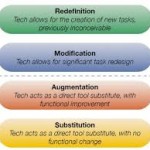I am a 5th grade teacher with 28 years experience working with students. I enjoy the challenge of creating meaningful, thought provoking lessons that engage my students. I believe students need to be prepared for the technological world they will be encountering as they progress into the work world. Not being a digital native has meant the learning curve bar has been set high. However, with a bit of effort and determination, I have learned how to effectively integrate technology through trial and error, reading, collaborating with colleagues and students, and attending conferences. So, my blogs will be filled with practical ideas that anyone at any level of confidence can try to use to enhance their teaching practice and achieve the goal of getting students prepared for their future!
Being an educator in the digital age has its rewards as well as its challenges. What it means is you have to be willing to spend the time to really evaluate not only the content you are required to teach, but also the tools/resources you use to teach the content with. You need to devote time to finding all the appropriate resources- be it books, apps, and/or websites. You need to ask yourself why am I choosing this application and how will my students benefit from using it?
By chance I stumbled into a session at the CUE Palm Springs Conference in March of 2014 and it was about the SAMR model. I was spell bound. It was the perfect fit for the start to my conference. I thought I had been doing a fabulous job- after all, I had been word processing, power pointing, and producing projects using technology for years. Then I realized, I was only substituting and augmenting. I was not really modifying or transforming my students’ work! Ultimately we are preparing our students for 21st century learning. So how do we shift our thinking and choices we make each day so we really do incorporate learning that promotes analyzing, evaluating, and creating? Use the SAMR model!
Dr. Ruben Puentedura developed the SAMR model as a guideline for teachers to evaluate just how you are utilizing the technology applications in your classroom. In addition, this model helps you promote the 4C’s: creation, critical thinking, collaboration, and communication via the application choices made.
In a nutshell, the model is a gauge for decoding the technological resources you choose to incorporate into your lessons. Remember, not every lesson will focus on transformation. Every “rung on the ladder” has value. The goal is to keep the focus of the choice. Some resources are just “Substitution” for enhancement like word processing applications. They just are a form of substitution for pen and paper if you are only using them as a typing program. The technology acts as a direct tool with no real change. Some math multiplication apps are like this. Yes, it may make the learning more fun and engaging, but it isn’t transforming the learning.
Some applications “Augment” the learning with some improvements. An example of this is when a student utilizes all the features in a word processing program to type, spell check, adjust, edit, and revise a piece. All this can be done without having to rewrite the entire piece over.
Crossing the line into transformation would be tools to create “Modification” where technology is being used to notably redesign a task. This could be using Google Slides and having students share and make comments to one another. They can create a production together on one document at the same time. Editing and or creating are done utilizing a form of communication that is instant. Students can even collaborate on projects from across the room!
Lastly there is “Redefinition” where the task is to create a complete new task previously unimaginable. This could look something like utilizing the app Tellagami to have an avatar tell the story that a student created. Then embed (app smashing) the tellagami into an imovie. If you want, this imovie could be shared and feedback comes from others in the community at large.
Therefore, using the SAMR model helps a teacher analyze what purpose is served by utilizing the application or form of technology. I even enjoy discussing this model with my students so they understand and can make informed decisions on technological choices. So next time you plan a lesson consider the SAMR model as a guide to assist your choices.
https://www.commonsensemedia.org/videos/introduction-to-the-samr-model



